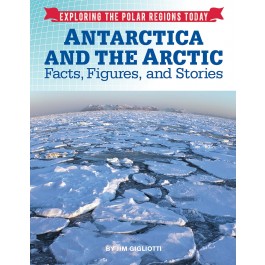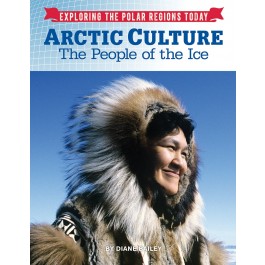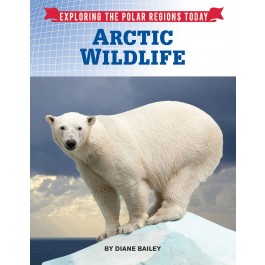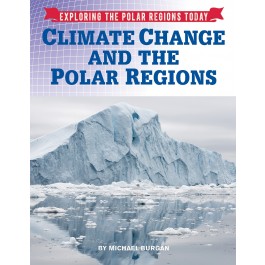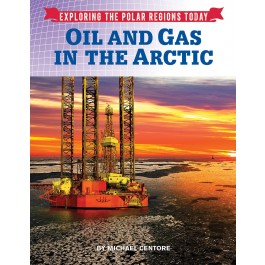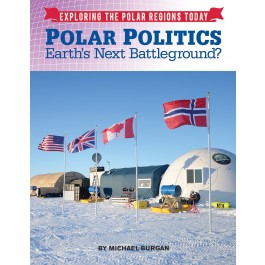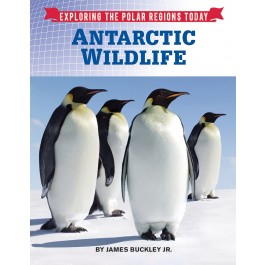EXPLORING THE POLAR REGIONS TODAY
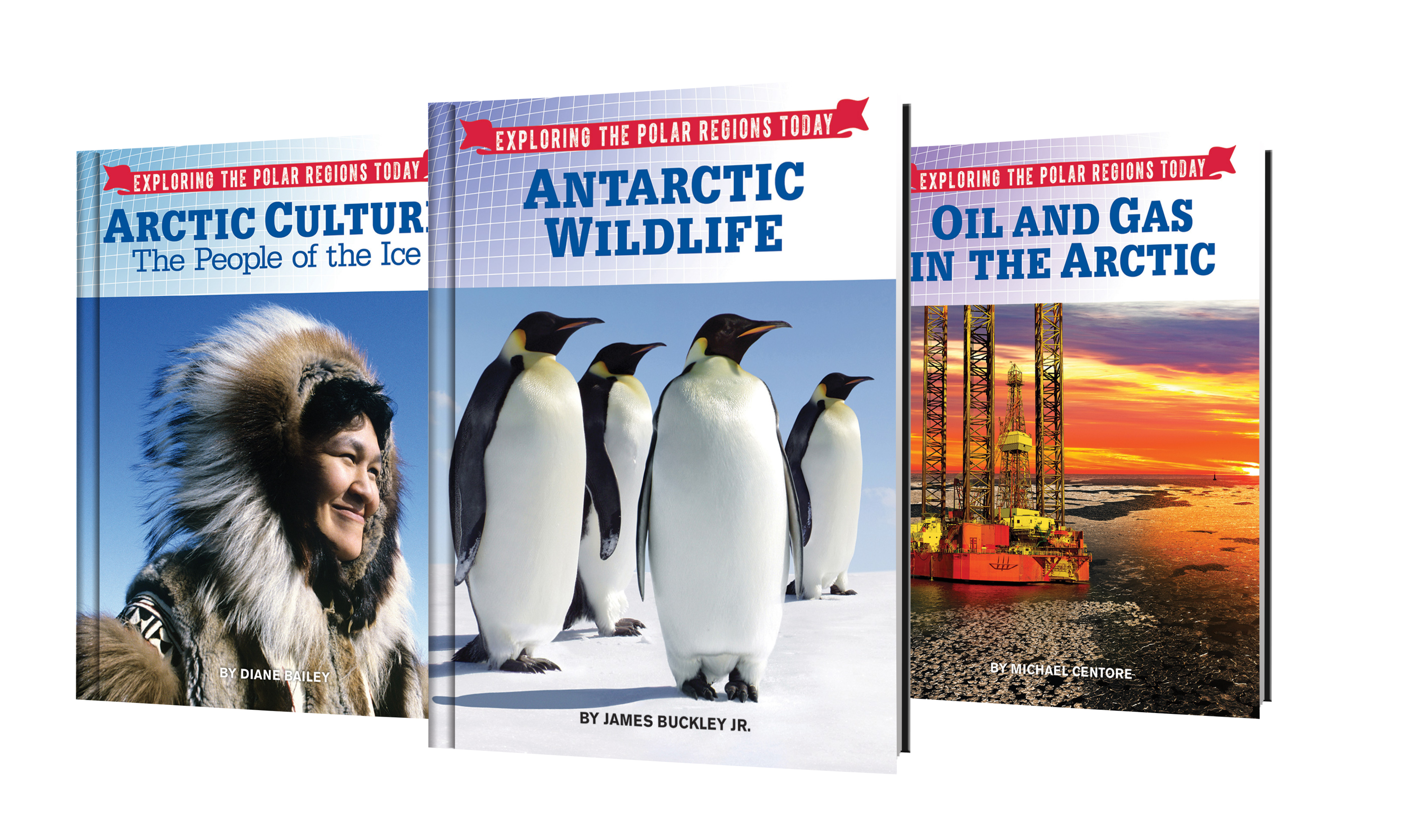
8
2018
12+
7th - 12th
7 X 9
by Jim Gigliotti
| Hardcover | ISBN 978-1-4222-3865-3 | $23.95 | Add To Cart |
| eBook | ISBN 978-1-4222-7920-5 | $29.95 | Add To Cart |
The North and South Poles have long fascinated scientists, explorers, and the general public. As more and more is learned about these unique places, they are taking on a greater importance on the world scene. In this book, learn the scientific and historical background of the Arctic and Antarctica, and come to understand why they are such a huge part of our future. You’ll get a great understanding of these remote, yet vital, places . . . and you won’t even have to wear a parka! Ice, ice, and more ice: That’s what most people think of the areas at the top and bottom of the world. But the Arctic and Antarctic are rapidly becoming the focus of world attention. Their role in climate change, their potential for energy exploration, and their place as home to amazing wildlife—to say nothing of their place in global politics—means that there has never been a better time for EXPLORING THE POLAR REGIONS TODAY. Key Icons appear throughout the books in this series in an effort to
encourage library readers to build knowledge, gain awareness, explore possibilities, and expand their viewpoints through our content rich nonfiction books. Words to Understand shown at the front of each chapter with definitions. These words are set in boldfaced color type in that chapter, so that readers are able to reference back to the definitions, building their vocabulary and enhancing their reading comprehension. Text-Dependent Questions are placed at the end of each title referring back to subjects covered within. They challenge the reader’s comprehension of the material they have just read, while sending the reader back to the text for more careful attention to the evidence presented there. Research Projects are provided at the end of each title as well and give readers suggestions for projects that encourage deeper research and analysis. Educational Videos are offered in chapters through the use of a QR code, that, when scanned, takes the student to an online video showing a moment in history, a speech, or an instructional video. This gives the readers additional content to supplement the text. A Series Glossary of Key Terms is included in the back matter containing terminology used throughout the series. Words found here broaden the reader’s knowledge and understanding of terms used in this field.
by Diane Bailey
| Hardcover | ISBN 978-1-4222-3866-0 | $23.95 | Add To Cart |
| eBook | ISBN 978-1-4222-7921-2 | $29.95 | Add To Cart |
People have lived above the Arctic Circle for thousands of years. They learned to adapt to the harsh environment, hunting, fishing, and surviving. But their survival has never been tested more than by the advance of civilization into their pristine wilderness. Inside, explore the fascinating culture of the people of the Arctic and find out why their future is in danger. Ice, ice, and more ice: That’s what most people think of the areas at the top and bottom of the world. But the Arctic and Antarctic are rapidly becoming the focus of world attention. Their role in climate change, their potential for energy exploration, and their place as home to amazing wildlife—to say nothing of their place in global politics—means that there has never been a better time for EXPLORING THE POLAR REGIONS TODAY. Key Icons appear throughout the books in this series in an effort to encourage library readers to build knowledge, gain awareness, explore possibilities, and expand their viewpoints through
our content rich nonfiction books. Words to Understand shown at the front of each chapter with definitions. These words are set in boldfaced color type in that chapter, so that readers are able to reference back to the definitions, building their vocabulary and enhancing their reading comprehension. Text-Dependent Questions are placed at the end of each title referring back to subjects covered within. They challenge the reader’s comprehension of the material they have just read, while sending the reader back to the text for more careful attention to the evidence presented there. Research Projects are provided at the end of each title as well and give readers suggestions for projects that encourage deeper research and analysis. Educational Videos are offered in chapters through the use of a QR code, that, when scanned, takes the student to an online video showing a moment in history, a speech, or an instructional video. This gives the readers additional content to supplement the text. A Series Glossary of Key Terms is included in the back matter containing terminology used throughout the series. Words found here broaden the reader’s knowledge and understanding of terms used in this field.
by Diane Bailey
| Hardcover | ISBN 978-1-4222-3867-7 | $23.95 | Add To Cart |
| eBook | ISBN 978-1-4222-7922-9 | $29.95 | Add To Cart |
Life in the Arctic wilderness is harsh and deadly. Yet many amazing animals survive and thrive there. Although polar bears are the most well-known, marine mammals of many kinds live in the icy oceans. As the land around the Arctic Circle becomes threatened by climate change and more, this rich animal life faces a host of perils. Inside, read more about them and find out how conservationists are trying to stem the tide of danger. Ice, ice, and more ice: That’s what most people think of the areas at the top and bottom of the world. But the Arctic and Antarctic are rapidly becoming the focus of world attention. Their role in climate change, their potential for energy exploration, and their place as home to amazing wildlife—to say nothing of their place in global politics—means that there has never been a better time for EXPLORING THE POLAR REGIONS TODAY. Key Icons appear throughout the books in this series in an effort to encourage library readers to build knowledge, gain awareness,
explore possibilities, and expand their viewpoints through our content rich nonfiction books. Words to Understand shown at the front of each chapter with definitions. These words are set in boldfaced color type in that chapter, so that readers are able to reference back to the definitions, building their vocabulary and enhancing their reading comprehension. Text-Dependent Questions are placed at the end of each title referring back to subjects covered within. They challenge the reader’s comprehension of the material they have just read, while sending the reader back to the text for more careful attention to the evidence presented there. Research Projects are provided at the end of each title as well and give readers suggestions for projects that encourage deeper research and analysis. Educational Videos are offered in chapters through the use of a QR code, that, when scanned, takes the student to an online video showing a moment in history, a speech, or an instructional video. This gives the readers additional content to supplement the text. A Series Glossary of Key Terms is included in the back matter containing terminology used throughout the series. Words found here broaden the reader’s knowledge and understanding of terms used in this field.
by Michael Burgan
| Hardcover | ISBN 978-1-4222-3868-4 | $23.95 | Add To Cart |
| eBook | ISBN 978-1-4222-7923-6 | $29.95 | Add To Cart |
The climate of the Earth is changing . . .and not for the better. Nowhere is this more apparent than in the Arctic and Antarctic. Scientists are watching with alarm as these vast regions of ice slowly melt, raising sea levels around the world. Inside, read more about how climate change is affecting the polar regions—including its people and wildlife—and how experts are working hard to solve the problems. Ice, ice, and more ice: That’s what most people think of the areas at the top and bottom of the world. But the Arctic and Antarctic are rapidly becoming the focus of world attention. Their role in climate change, their potential for energy exploration, and their place as home to amazing wildlife—to say nothing of their place in global politics—means that there has never been a better time for EXPLORING THE POLAR REGIONS TODAY. Key Icons appear throughout the books in this series in an effort to encourage library readers to build knowledge, gain awareness, explore
possibilities, and expand their viewpoints through our content rich nonfiction books. Words to Understand shown at the front of each chapter with definitions. These words are set in boldfaced color type in that chapter, so that readers are able to reference back to the definitions, building their vocabulary and enhancing their reading comprehension. Text-Dependent Questions are placed at the end of each title referring back to subjects covered within. They challenge the reader’s comprehension of the material they have just read, while sending the reader back to the text for more careful attention to the evidence presented there. Research Projects are provided at the end of each title as well and give readers suggestions for projects that encourage deeper research and analysis. Educational Videos are offered in chapters through the use of a QR code, that, when scanned, takes the student to an online video showing a moment in history, a speech, or an instructional video. This gives the readers additional content to supplement the text. A Series Glossary of Key Terms is included in the back matter containing terminology used throughout the series. Words found here broaden the reader’s knowledge and understanding of terms used in this field.
by Michael Centore
| Hardcover | ISBN 978-1-4222-3869-1 | $23.95 | Add To Cart |
| eBook | ISBN 978-1-4222-7924-3 | $29.95 | Add To Cart |
Beneath the storm-tossed seas at the top of the world, and under the spreading sheets of ice lies what could be billions of barrels of oil and gas—perhaps 15–30 percent of world totals. Getting at that valuable resource, however, could cause more problems than it solves. Drilling for oil in the Arctic raises political, environmental, and sociological problems. It’s also ratcheting up international tension. Inside, find out what’s up there . . . and who wants it. Ice, ice, and more ice: That’s what most people think of the areas at the top and bottom of the world. But the Arctic and Antarctic are rapidly becoming the focus of world attention. Their role in climate change, their potential for energy exploration, and their place as home to amazing wildlife—to say nothing of their place in global politics—means that there has never been a better time for EXPLORING THE POLAR REGIONS TODAY. Key Icons appear throughout the books in this series in an effort to encourage library
readers to build knowledge, gain awareness, explore possibilities, and expand their viewpoints through our content rich nonfiction books. Words to Understand shown at the front of each chapter with definitions. These words are set in boldfaced color type in that chapter, so that readers are able to reference back to the definitions, building their vocabulary and enhancing their reading comprehension. Text-Dependent Questions are placed at the end of each title referring back to subjects covered within. They challenge the reader’s comprehension of the material they have just read, while sending the reader back to the text for more careful attention to the evidence presented there. Research Projects are provided at the end of each title as well and give readers suggestions for projects that encourage deeper research and analysis. Educational Videos are offered in chapters through the use of a QR code, that, when scanned, takes the student to an online video showing a moment in history, a speech, or an instructional video. This gives the readers additional content to supplement the text. A Series Glossary of Key Terms is included in the back matter containing terminology used throughout the series. Words found here broaden the reader’s knowledge and understanding of terms used in this field.
by Diane Bailey
| Hardcover | ISBN 978-1-4222-3870-7 | $23.95 | Add To Cart |
| eBook | ISBN 978-1-4222-7925-0 | $29.95 | Add To Cart |
The lure of discovery and adventure has long attracted hardy souls to the North and South Poles. For more than a century, using dogsleds, animal skins, and wooden ships, explorers tried to reach the top and bottom of the Earth. Their sometimes-deadly treks became international legends. With today’s modern methods, exploration of these vast regions continues. Inside, meet the brave people who first heard the call of the ice, as well as the modern experts who strive to add to those early discoveries. Ice, ice, and more ice: That’s what most people think of the areas at the top and bottom of the world. But the Arctic and Antarctic are rapidly becoming the focus of world attention. Their role in climate change, their potential for energy exploration, and their place as home to amazing wildlife—to say nothing of their place in global politics—means that there has never been a better time for EXPLORING THE POLAR REGIONS TODAY. Key Icons appear throughout the books in this series in
an effort to encourage library readers to build knowledge, gain awareness, explore possibilities, and expand their viewpoints through our content rich nonfiction books. Words to Understand shown at the front of each chapter with definitions. These words are set in boldfaced color type in that chapter, so that readers are able to reference back to the definitions, building their vocabulary and enhancing their reading comprehension. Text-Dependent Questions are placed at the end of each title referring back to subjects covered within. They challenge the reader’s comprehension of the material they have just read, while sending the reader back to the text for more careful attention to the evidence presented there. Research Projects are provided at the end of each title as well and give readers suggestions for projects that encourage deeper research and analysis. Educational Videos are offered in chapters through the use of a QR code, that, when scanned, takes the student to an online video showing a moment in history, a speech, or an instructional video. This gives the readers additional content to supplement the text. A Series Glossary of Key Terms is included in the back matter containing terminology used throughout the series. Words found here broaden the reader’s knowledge and understanding of terms used in this field.
by Michael Burgan
| Hardcover | ISBN 978-1-4222-3871-4 | $23.95 | Add To Cart |
| eBook | ISBN 978-1-4222-7926-7 | $29.95 | Add To Cart |
Unlike most of the Earth, no country truly “owns” the Arctic and Antarctic. And anytime you have something that no one owns . . . everyone wants to get a piece of it. The struggle for political, geographic, and scientific control of the lands that surround the poles is heating up, especially as oil and gas—perhaps 15–30 percent of world totals—become accessible in the Arctic due to climate change. What’s next for these vital regions? Can the world come together at the point where the latitudes do? Ice, ice, and more ice: That’s what most people think of the areas at the top and bottom of the world. But the Arctic and Antarctic are rapidly becoming the focus of world attention. Their role in climate change, their potential for energy exploration, and their place as home to amazing wildlife—to say nothing of their place in global politics—means that there has never been a better time for EXPLORING THE POLAR REGIONS TODAY. Key Icons appear throughout the books in this
series in an effort to encourage library readers to build knowledge, gain awareness, explore possibilities, and expand their viewpoints through our content rich nonfiction books. Words to Understand shown at the front of each chapter with definitions. These words are set in boldfaced color type in that chapter, so that readers are able to reference back to the definitions, building their vocabulary and enhancing their reading comprehension. Text-Dependent Questions are placed at the end of each title referring back to subjects covered within. They challenge the reader’s comprehension of the material they have just read, while sending the reader back to the text for more careful attention to the evidence presented there. Research Projects are provided at the end of each title as well and give readers suggestions for projects that encourage deeper research and analysis. Educational Videos are offered in chapters through the use of a QR code, that, when scanned, takes the student to an online video showing a moment in history, a speech, or an instructional video. This gives the readers additional content to supplement the text. A Series Glossary of Key Terms is included in the back matter containing terminology used throughout the series. Words found here broaden the reader’s knowledge and understanding of terms used in this field.
by James Buckley Jr.
| Hardcover | ISBN 978-1-4222-3864-6 | $23.95 | Add To Cart |
| eBook | ISBN 978-1-4222-7919-9 | $29.95 | Add To Cart |
The Antarctic is almost nothing but ice. Amid this frozen wasteland, however, animal life can survive. Penguins of many kinds live in these icy Southern regions, while the seas around the continent teem with marine life. The islands near the bottom of the world are home to a diverse group of birds, too. But growing interest in the Antarctic is bringing peril to wildlife. Inside, read how experts are trying to make sure penguins and their fellow animals survive. Ice, ice, and more ice: That’s what most people think of the areas at the top and bottom of the world. But the Arctic and Antarctic are rapidly becoming the focus of world attention. Their role in climate change, their potential for energy exploration, and their place as home to amazing wildlife—to say nothing of their place in global politics—means that there has never been a better time for EXPLORING THE POLAR REGIONS TODAY. Key Icons appear throughout the books in this series in an effort to encourage library readers to
build knowledge, gain awareness, explore possibilities, and expand their viewpoints through our content rich nonfiction books. Words to Understand shown at the front of each chapter with definitions. These words are set in boldfaced color type in that chapter, so that readers are able to reference back to the definitions, building their vocabulary and enhancing their reading comprehension. Text-Dependent Questions are placed at the end of each title referring back to subjects covered within. They challenge the reader’s comprehension of the material they have just read, while sending the reader back to the text for more careful attention to the evidence presented there. Research Projects are provided at the end of each title as well and give readers suggestions for projects that encourage deeper research and analysis. Educational Videos are offered in chapters through the use of a QR code, that, when scanned, takes the student to an online video showing a moment in history, a speech, or an instructional video. This gives the readers additional content to supplement the text. A Series Glossary of Key Terms is included in the back matter containing terminology used throughout the series. Words found here broaden the reader’s knowledge and understanding of terms used in this field.











